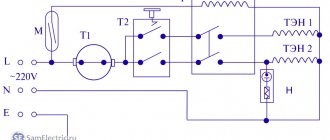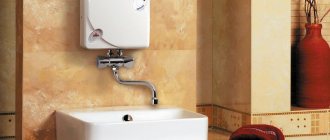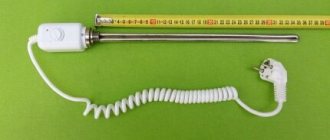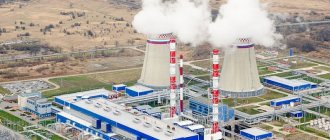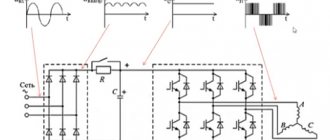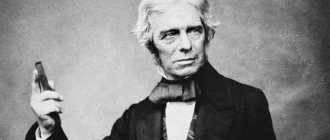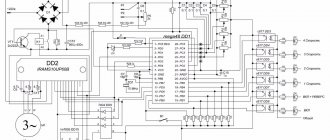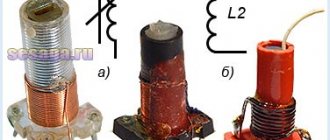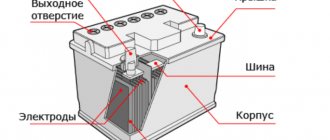0
6365
14.12.2015
The problem of lack of hot water supply is quite widespread in most of our cities. Even where it exists in principle, there are periods when there is simply no hot water in the tap. A storage water heater is an acceptable solution to this problem. There are other types of water heating equipment, but in this article we will look at storage water heaters: the operating principle of these devices, features of operation, maintenance and repair. These devices can be powered by burning gas, electricity and even solar energy, the main thing is that they meet the requirements for this type of household appliance.
Design of an electric storage water heater
The basic configuration of electric storage hot water equipment is presented:
- standard case;
- a tank with a heat-insulating layer;
- heating elements in the form of heating elements;
- protective magnesium anode;
- thermostat;
- control unit;
- security system;
- indicator element;
- electrical cable.
In this type of equipment, the use of hot water is possible only after full heating, so a preliminary process of preparing the liquid is mandatory.
The design of electric-type water-heating storage equipment is standard and includes several basic structural elements, which may differ in technical features and characteristics.
Boiler design
In this diagram you can see the main elements of the boiler design.
A boiler is a device that heats and stores hot water. Structurally, it is a container of one volume or another, equipped with thermal insulation and a heating element. The water supplied to the tank is heated to a predetermined temperature, after which it can be used by consumers. The heating temperature is adjusted and maintained using a built-in thermostat. The maximum temperature reaches +70-80 degrees. Most boilers have a pressure design. That is, the outlet water flows under the same pressure under which it is supplied to the unit’s tank. If the supply of cold water stops, then it will not be possible to get water from the storage water heater - it simply will not flow out of it. Thus, the water in the tank is under constant pressure (increasing with heating).
How does a boiler work and what components will we find in its interior?
- A tank with a protective coating is the basis of any storage water heater. Tanks are made of metal and coated with enamel or glass-ceramics to prevent corrosion. Tank capacity varies from 10 to 300 liters;
- Heating element – inside boilers we can find one or two heating elements. They are responsible for heating the water (in gas boilers this function is performed by the burner);
- Thermostat – provides support for the set temperature (mechanical or electronic adjustment is used);
- The control panel is hidden or open, it is used to set the temperature;
- Thermometer – provides control of the temperature of the water in the tank. The thermometer can be mechanical or electronic.
The design of boilers is extremely simple, and the main volume is occupied by massive tanks of varying capacities.
Water heating device housing
Electric storage boilers are usually characterized by the presence of an outer shell, represented by a steel casing. Water heating devices with a minimum useful volume, which does not exceed 15 liters, are most often produced with a high-strength plastic housing.
Horizontal storage water heater
The model range represented by water heating devices with a volume of 30 liters most often have a combined metal-plastic body. Currently, cylindrical, rectangular and slim type devices are produced in shape.
You will learn how to install a water heater in a bathroom on our website. General rules and recommendations.
The criteria for choosing an electric water boiler are presented here.
Which water heater is better to choose - instantaneous or storage? A comparison of these devices is provided at the link.
How to save energy?
You can save a little on the electricity that the boiler consumes during operation. For this it is recommended:
- Set the heating temperature not to the maximum (75-85 degrees), but to 55-60. When cold water enters the tank and combines with the liquid that is already there, less energy will be needed to heat the mixed mass. In addition, a temperature regime of 55-60 degrees will help to significantly reduce the process of scale formation on the heater.
- It is necessary to choose the correct location of the boiler so that the pipeline from it to the sink or shower is not too long. Due to this, the heat from hot water will dissipate less.
- Periodically it is necessary to carry out preventive cleaning of the heating element from scale. Due to this procedure, its operating efficiency increases - the energy costs for heat generation will be less.
22e65a3b7f400f308f4218b9c699320a.html
Tank Features
The most modern storage water heaters have a tank made of stabilized and high-strength steel alloys, which are characterized by resistance to corrosive changes.
The inner surface is covered with a layer of glass porcelain, which is subjected to high-temperature firing. The porcelain glass coating is chemically neutral and corrosion-resistant.
Storage water heater design for vertical installation
The special crystalline structure of the porcelain glass tank can withstand even very high deforming loads . The internal tank is protected by a magnesium anode, which effectively prevents electrochemical corrosion processes.
Periodic replacement of such an element has a positive effect on the service life of the water heating device.
Gas heaters
- A storage gas boiler uses a gas burner as a heating element. The power and heating speed of a gas water heater are higher. But to install a gas storage boiler, you need equipment for exhaust gas removal.
The design of the gas storage water heater also includes a control device. The photo shows that in appearance, only the presence of forced gas removal distinguishes electric and gas storage boilers.
Storage-type boilers also require the installation of special safety fittings, which include a check valve, a safety valve and a reducer.
The video below shows different types of storage boilers and examples of their installation.
- Flow-through gas boilers are also called geysers. The principle of operation is the same, the difference is in the design and method of ignition. In appearance, a gas water heater is a metal box, to which two pipes fit, one with water, the other with gas. Main parts of the structure:
- heat exchanger;
- main burner;
- pilot burner.
The gas released during combustion of the main burner is sufficient to heat water in a heat exchanger made in the form of a spiral. Modern models of geysers use electronic ignition.
Forced or natural exhaust gas removal is also necessary
When using geysers as hot water equipment, special attention must be paid to good ventilation of the room
Indirect heater
An indirect water heating boiler uses heat generated, for example, by a home heating system. The main convenience is the use of water from the heater at several points in the house, since the device has a supply of hot water in the tank. Externally, the indirect water heater is also cylindrical in shape, but rectangular options are also possible.
The design consists of a tank, inside of which a heat exchanger is placed with coolant circulating through it. Inside there is a magnesium anode designed to prevent corrosion of the internal surface of the boiler. The anode is part of a safety system group that also includes a check valve, an overpressure valve and a temperature sensor.
It is advantageous to purchase an indirect heating water heater together with a single-circuit heating boiler. Although together this unit costs more than a double-circuit boiler and is a more bulky structure, it provides an almost uninterrupted supply of hot water to several points, with a uniform temperature of the supplied water.
Models of vertical and horizontal installation boilers are available, which are installed depending on the area of the room; vertical ones are attached to the wall and take up less space. Models without heat exchangers consist of containers inserted into one another, with coolant circulating between them. A combination boiler option is possible, in which water is heated both from an external source and from a heating element.
Modern water heaters are equipped with thermostats that ensure safe operation of the device. Replenishment of water used from the water heater occurs automatically. The reliability and durability of the boiler also depends on the internal coating of the tank, which today is mainly made of glass porcelain and enamel. The heating time of water in a water heater depends on the power of the heating element. The power of gas boilers is twice that of electric ones.
There are also non-pressure open boilers, although they provide hot water to one point, they are applicable in systems with little or no water pressure.
Summarizing all of the above, it should be noted that the operating principle of all modern boilers is simple, which makes them indispensable for rooms in which there is no centralized supply of hot water.
Heating elements and magnesium anode
One of the main structural elements of water heating equipment is a steel flange used to fix a thermo-electric heater in the form of a nichrome spiral in a copper casing, as well as a magnesium sacrificial anode and thermostat.
A feature of the removable type support flange is that it is secured to the equipment body using a conventional threaded or bolted connection.
Magnesium anode
Connection diagram and installation
The storage water heater should be installed in strict accordance with the installation instructions, which you will definitely find in the user manual.
We want to give you several recommendations that will allow you to connect the device to communications as efficiently and safely as possible.
- The boiler should be installed against a wall; at the same time, make sure that the pipes for hot and cold water are strictly parallel to it. There should be a small distance between the water heater and the wall, allowing for preventive inspection and maintenance of node connections.
- It is recommended to use a ¾-inch diameter pipe to connect to the water supply. Stand facing the appliance: the hot water pipe should be located on your left hand, and the cold water pipe should be on your right hand.
- Using a safety valve for storage water heaters will help avoid overheating of the device and associated unpleasant consequences.
- Before you start connecting the boiler to the water pipes, open the cold water tap. Make sure it is clean enough to be free of sand, rust particles and other small debris. If necessary, cut a special water filter into the pipe (in the section of the network before the water heater).
- It is also recommended to check the pressure in the water pipes before starting installation. Its level should not be higher than 8 bar. If this figure is exceeded, a pressure reducer should be installed.
- Drops of water falling from the hydraulic valve are a sign of normal operation of the device and the water supply network. But it is necessary to ensure that water from the valve does not fall on the body of the water heater. To do this, you need to attach a special drain funnel to the valve with an outlet into the sewer.
- If the boiler is installed in a country house that does not have constant heating, you need to make sure that there is no water left in the tank when the outside temperature drops below zero. Therefore, when leaving the house in the cold season, always drain the remaining liquid from the tank, otherwise the device may fail.
Principle of operation
Let's look at how an electric storage water heater works. Electric storage water heating equipment is distinguished by a special operating principle based on the movement of the hottest water layers upward and the shift of cold water, which has a high density, to the lower part of the tank with heating elements.
The initial connection of a water heating device to the electrical network is accompanied by turning on the heating element and heating the water to a temperature condition at which the thermostat contacts provoke the opening of the electrical circuit.
Operating principle of a water heater
The process of inversion of water heated to the specified parameters into the supply main system is prevented by the installed non-return valve device. It is thanks to the presence of such fittings that the water flow moves in only one direction.
Opening the supply tap at the water point causes hot water to flow to consumers through a special pipe, which is accompanied by a decrease in pressure inside the storage tank. As a result, the water heating tank is filled with cold water from the water supply system.
The presence of a functional divider at the inlet pipe does not allow hot water to mix with the cold water flows entering the water heating tank. The dissecting device distributes the jet and at the same time reduces the speed of its movement. It is for this reason that the flow of cold water is evenly distributed over the very bottom of the water heating device, which allows the installed heating element to carry out effective heating.
In normal mode, a decrease in the temperature of the water in the tank causes the contacts of the thermostat to close and subsequently connect to the electrical network.
Instantaneous water heater
The design of an instantaneous water heater is completely different from the operating principle of storage equipment. This device does not have a container for storing water, and it is heated with a constant flow of liquid through the heating module. Such a module uses a structure made of pipes with heating elements, which can be located both outside and inside the structure. The best material for making a heating module is copper, but cheaper models may use stainless steel or aluminum.
In addition to the water heating module, the device includes various additional devices. A water flow sensor is necessary to determine the minimum water pressure at which the water heater can be operated. Temperature sensor and temperature controller (thermostat) are designed to control operating modes. The thermal fuse switches off the system when the maximum possible water flow temperature is exceeded. The picture below shows a classic cross-sectional diagram of an electric instantaneous water heater.
How does an instantaneous water heater work? This process will be clear even to a schoolchild! From the presented diagram it is clear that cold water enters the device through the pipe, and access to the heating module is provided by a pressure switch. If the pressure is low, the water heater will not function. The temperature controller controls the heating process. Water, heated to the required temperature, is discharged outside and supplied to the mixer for use by the consumer. The advantages of instantaneous electric water heaters include low cost and instant heating of water, while the disadvantages are high power consumption and special conditions for electrical wiring.
Scheme of operation of a storage water heater
The standard operating scheme of water heating equipment is based on the principle of separating several water layers that differ in different temperature conditions. Hot liquid is withdrawn from the water heater through the hot water supply pipe.
Such a tube has a strictly defined length, reaching the upper, most heated layer. The laws of physics do not allow a water heating device of a vertical design to be placed in parallel.
Electrical circuit of a storage water heater
When choosing an electric heating storage boiler, you need to pay attention to its design features, as well as take into account the basic rules for installing a water heating device.
Pros and cons of boilers
Using a boiler, you can heat a large volume of water.
In the absence of a centralized hot water supply system, boilers are used. Their advantages include the following:
- Ease of use.
- Large volume can be heated.
- One device can be used to supply several rooms.
- The operation of the device does not depend on the pressure force.
- Possibility of heating to high temperatures.
- Maintaining high temperatures for a long time thanks to high-quality thermal insulation of the tank.
A large boiler requires a lot of space.
The disadvantages include the following:
- Long time for initial heating.
- If water flow is low, maintaining a constant temperature will incur energy costs.
- A large tank requires sufficient territory.
- The cost is higher than that of a flow-through product.
If there are problems with the water supply, you can install a boiler in an apartment building. The design and principle of operation will depend on the type of device, its functionality and additional functions.
What is a boiler, its purpose
A boiler is a device for heating water, fully automated. It has different shapes, round, square, flat or elongated. It can be mounted both vertically and horizontally (certain models). Boilers differ in heating method, mounting features and volume. Also by type of coating: glass porcelain, enamel, titanium enamel, stainless steel. Also according to the principle of operation: flow-through and storage. The purpose of the unit is to collect water, heat it, and maintain the desired temperature. It is used both for home (apartment, country house, cottage) and public use (bars, restaurants, saunas, office).
The purpose of such devices is to supply hot water to the user in a completely autonomous mode.
